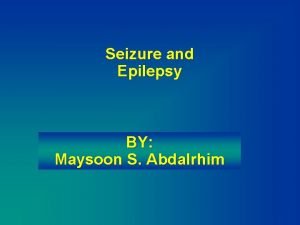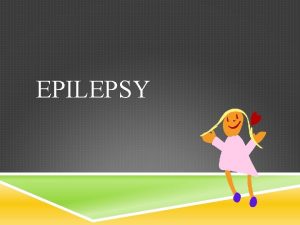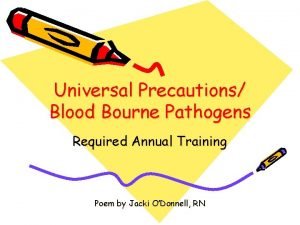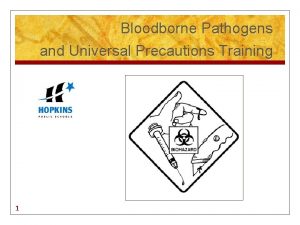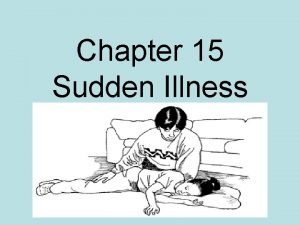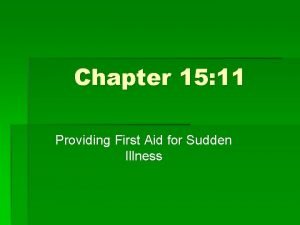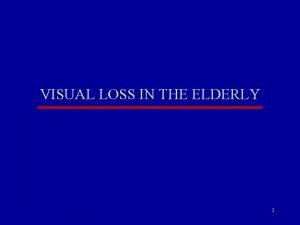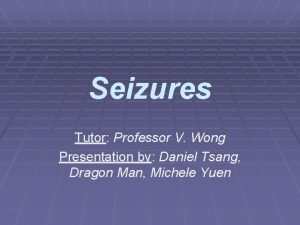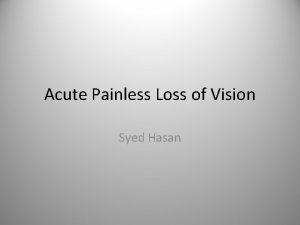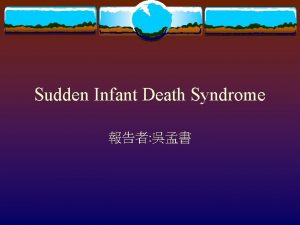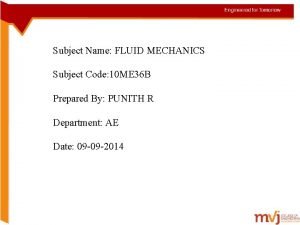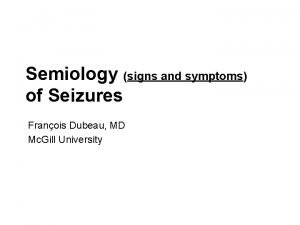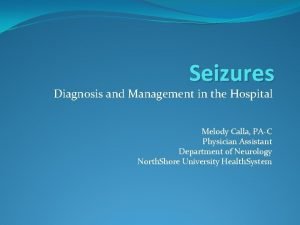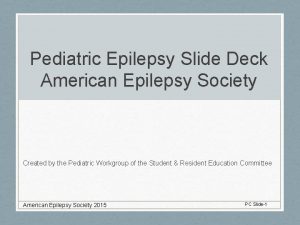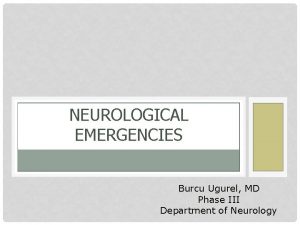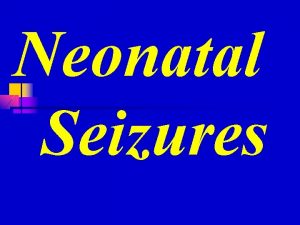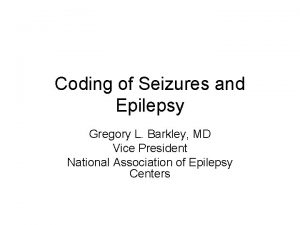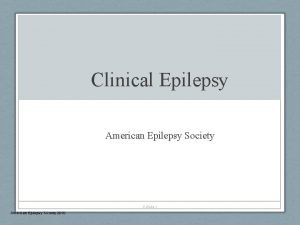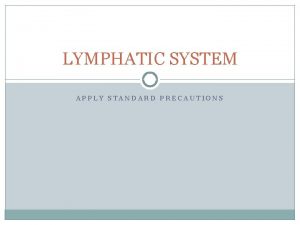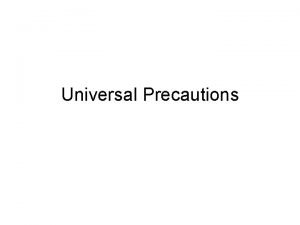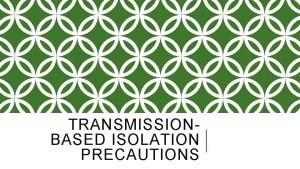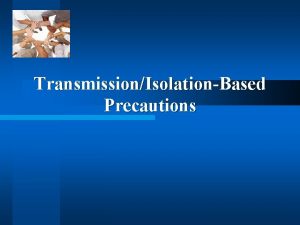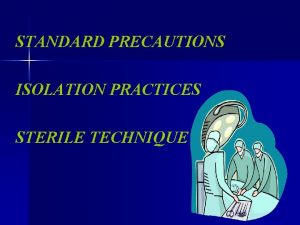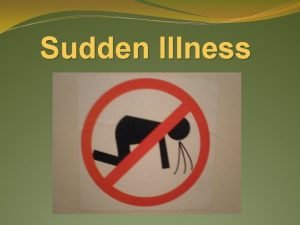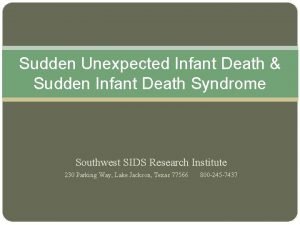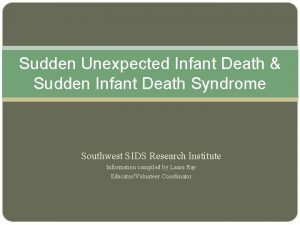TRAINING SEIZURE PRECAUTIONS A seizure is a sudden






































- Slides: 38

TRAINING SEIZURE PRECAUTIONS

A seizure is a sudden surge of electrical activity in the brain that usually affects how a person feels or acts for a short time.

There are two types of seizures 1. Grand mal seizure 2. Petit mal seizure

A petit mal seizure is the name given to a staring spell. It last for a maximum of 15 seconds and is caused by disturbance of brain function due to abnormal electrical activity in the brain.

A grand mal seizure involves a loss of consciousness and violent muscle contractions. It's the type of seizure most people picture when they think about seizures in general.

Today we are going to look at seizure precautions regarding grand mal seizures.

Grand mal seizure is caused by abnormal electrical activity throughout the brain.

� In some cases, this type of seizure is triggered by other health problems, such as extremely low blood sugar or a stroke.

� In most cases a grand mal seizure is triggered by epilepsy.

A grand mal seizure has two stages. Stage 1: Tonic Phase Stage 2: Clonic Phase

� Tonic phase - Loss of consciousness occurs, and the muscles suddenly contract and cause the person to fall down. This phase tends to last about 10 to 20 seconds.

Clonic phase -The muscles go into rhythmic contractions, alternately flexing and relaxing. Convulsions usually last for less than two minutes.

Other symptoms may occur such as: Aura - Some people experience a warning feeling (aura) before a grand mal seizure. This warning varies from person to person, but may include feeling a sense of unexplained dread, a strange smell or a feeling of numbness.

A scream - Some people may cry out at the beginning of a seizure because the muscles around the vocal cords seize, forcing air out.

Loss of bowel and bladder control - This may happen during or following a seizure.

Unresponsiveness after convulsions Unconsciousness may persist for several minutes after the convulsion has ended.

Confusion - A period of disorientation often follows a grand mal seizure. This is referred to as postictal confusion.

Fatigue - Sleepiness is common after a grand mal seizure

Severe headache - Headaches are common but not universal after grand mal seizures.

WHAT TO DO?

REMAIN CALM!

WHAT TO DO Gently roll the person onto one side and put something soft under his or head.

WHAT TO DO Loosen tight neckwear.

WHAT TO DO Clear a space around the person, moving away objects that could be harmful.

WHAT NOT TO DO Do not put anything in the mouth — the tongue can't be swallowed and objects placed in the mouth can be bitten or inhaled.

WHAT NOT TO DO Do not try to restrain the person. Allow the seizure to run its course.

YOU NEED TO CALL 911 WHEN: � The seizure lasts longer than five minutes � The seizure lasts longer than is usual for the person involved � The person has a series of seizures without regaining consciousness in between � The person has received injuries during the seizure.

AFTER THE SEIZURE Allow the individual to rest to recover from the seizure.

Encourage the individual with seizure to lead a normal life, but take some precautions. � DO NOT allow the individual to swim unsupervised. � Check on the individual while the individual is in the shower. � Check on the individual while he is sleeping. � If the individual is going to ride a bicycle, make sure he wears a helmet.

QUICK NOTES STAY CALM !!! MOST SEIZURES LASTS ONLY A FEW MINUTES

PREVENT INJURY BY MOVING NEARBY OBJECTS OUT THE WAY

PAY ATTENTION TO THE LENGTH OF THE SEIZURE. YOU NEED TO DOCUMENT THIS INFORMATION.

DO NOT HOLD THE PERSON DOWN. ALLOW THE SEIZURE TO RUN ITS COURSE

IF THE SEIZURES CONTINUES FOR MORE THAN 5 MINUTES, CALL 911.

DO NOT PUT ANYTHNG IN THE PERSON’S MOUTH.

BE SENSITIVE AND SUPPORTIVE.

QUESTIONS AND ANSWERS

Hope of Columbus, Inc.
 Baseline vital signs
Baseline vital signs Seizure precautions bed rails
Seizure precautions bed rails Seizure precautions bed rails
Seizure precautions bed rails Barrier technique in burns
Barrier technique in burns Blood bourne pathogens
Blood bourne pathogens Universal precautions training
Universal precautions training Sudden successive flights of bullets
Sudden successive flights of bullets Sudden oak death map
Sudden oak death map Gradual contraction loss coefficient
Gradual contraction loss coefficient Head loss formula for sudden contraction
Head loss formula for sudden contraction Chapter 17 1 providing first aid
Chapter 17 1 providing first aid Name 5 sudden illness.
Name 5 sudden illness. Providing first aid for sudden illness
Providing first aid for sudden illness Gradual closure of valve
Gradual closure of valve The sudden release of energy stored in rocks causes a(n)
The sudden release of energy stored in rocks causes a(n) Not genuine, not true, not valid
Not genuine, not true, not valid Sudden fiction meaning
Sudden fiction meaning Yas 35 dante gibi
Yas 35 dante gibi Sudden painless loss of vision
Sudden painless loss of vision Sudden painless loss of vision
Sudden painless loss of vision Sudden attack projetista
Sudden attack projetista A sudden blow the great wings beating still
A sudden blow the great wings beating still Dr hasan syed
Dr hasan syed Pipe system
Pipe system Sudden oak death map
Sudden oak death map You have been mine before
You have been mine before Livedo mortis
Livedo mortis Fluid mechanics subject code
Fluid mechanics subject code How many syllables in guitar
How many syllables in guitar Sudden death proc
Sudden death proc Ictal phase
Ictal phase Provoked seizure
Provoked seizure Difference between seizure and epilepsy
Difference between seizure and epilepsy Myoclonic seizure symptoms
Myoclonic seizure symptoms Breakthrough seizure
Breakthrough seizure Porognosis
Porognosis Warning signs of a seizure
Warning signs of a seizure Gregory barkley
Gregory barkley Migraine aura vs seizure aura
Migraine aura vs seizure aura

